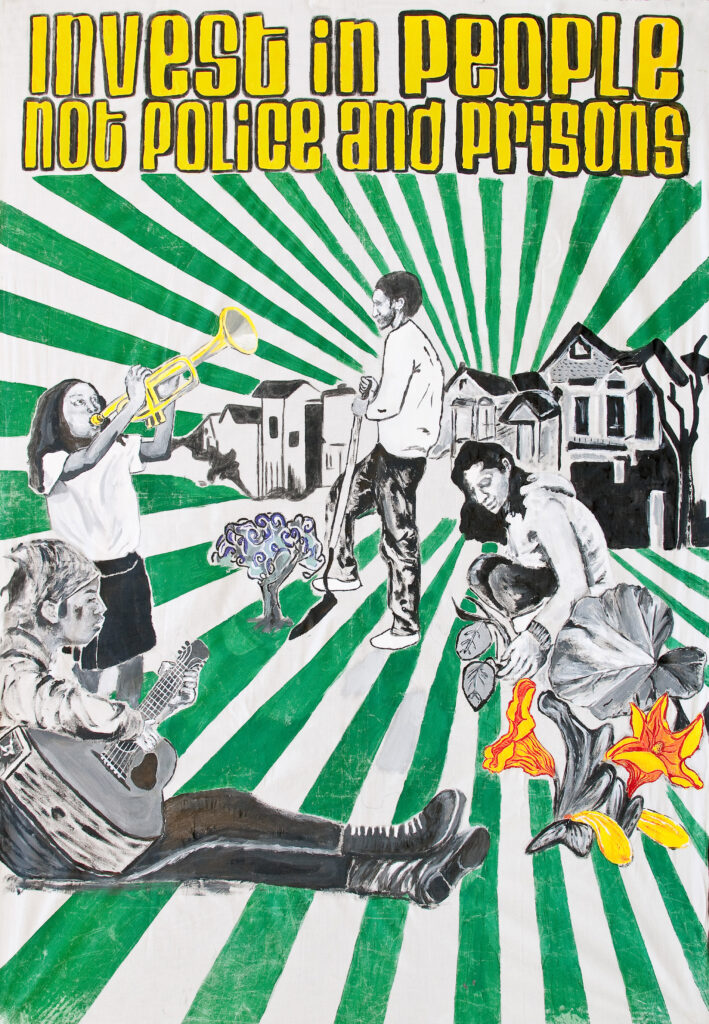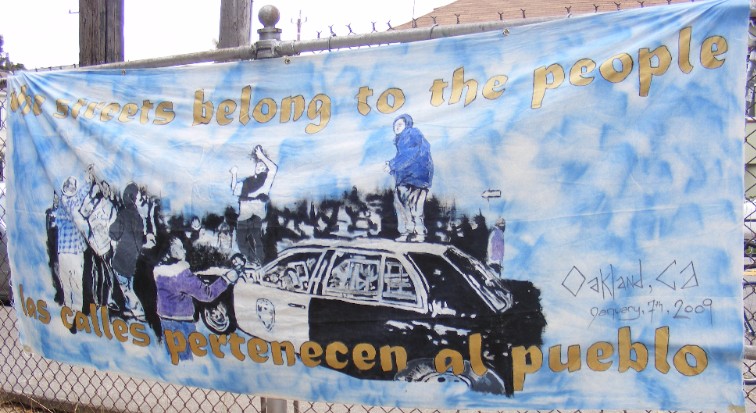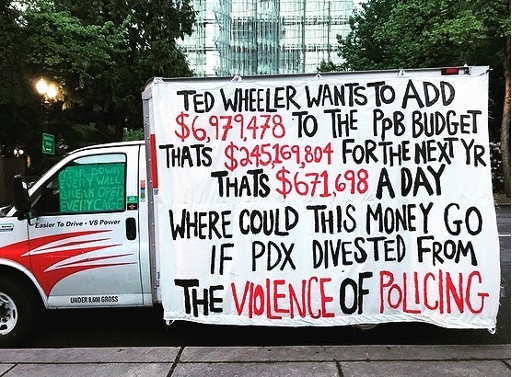Near the end of May 2020, uprisings set off around the world uplifting a range of calls to remedy state violence and racial capitalism. At this juncture, our communities are mounting strong demands for structural change, including strategies to defund police and cancel contracts or entire police programs and initiatives. 10 years ago holding a sign that read “Abolish Police” at a protest garnered blank stares or even hostility. Now abolition is becoming a household term.
In this moment of upheaval, we examine how a layered set of conditions, beliefs and triggers have cooked this particular moment of rebellion and deep shifting in order to analyze the development and growth of the abolitionist movement today.
The Conditions: What conditions have led to this moment?
US management of the Covid-19 pandemic resulted in an economic collapse in which entire social and economic institutions have tumbled. In three months, US unemployment surpassed the unemployment rate of the Great Recession. Millions of workers are still unemployed as a result of mandatory non-essential business closures, stay-at-home orders and health concerns. Altering American life as we know it, the COVID Crisis cancelled the many social distractions and dependencies the US economy has relied on and that we became accustomed to, including professional sports and mass events.
COVID has also exacerbated and exposed the gross inequities and structural oppression of capitalism that make communities of color more vulnerable. As Ruth Wilson Gilmore defines racism as “the state sanctioned and/or legal production and exploitation of group-differentiated vulnerabilities to premature death, in distinct yet densely interconnected political geographies,” people of color experience racism as a set of political and economic conditions that compromise the quality or longevity of their lives. The COVID-19 pandemic underscores this reality quite clearly. In the US, Black people are dying from the coronavirus at a rate 2.3 times greater than white people. To put it more bluntly, if people of color were dying from the virus at the same rates as white people, 16,000 Black people, 2,200 Latino people and 400 Indigenous people would still be alive as of early July 2020. Systemic disinvestment and the active use of racism as a tool in creating policies in the public and private sector has made it infinitely more difficult for people of color to access quality health care, find stable jobs that pay a liveable wage, access healthy food and find safe, affordable housing.
The interplay of COVID-19 with the prison industrial complex makes this picture even more stark when we consider the conditions which people who are currently locked up in jails and prisons across the US are experiencing (by mid-July over 64,000 people in jails and prisons had tested positive for the virus) and the increased police presence on the streets of our cities as people protest not only the seemingly unending murder of Black people by cops, but also the economic conditions that further entrench the power of policing in Black and Brown communities.
In this moment of crisis and upheaval, the federal government simultaneously refuses to fully acknowledge the state of emergency that we are in and yet keeps in place Title 42 pandemic law, Trump’s pandemic emergency declaration which has allowed for the expanded use of police on our streets. On one hand we see militarized police forces, alongside increased collaboration with ICE, equipped with tanks, riot gear, tear gas and flash bang grenades deployed to attack protesters. On the other hand, healthcare workers, hospitals and facilities beg for personal protective equipment and ventilators to treat sick and dying patients. Our analysis is that the disconnect is not coincidental.
These conditions coupled with generations of localized organizing that have uplifted collective resistance to policing and generated shareable strategies and tactics to strategically target specific parts of the institution of policing is shifting power to community self-determination. The development of Black Lives Matter Movement has helped shape the conditions of our organizing now, especially as part of the gains the Black Lives Matter movement has made expand public consciousness to the particular ways Black people experience racism, premature, systemic death, white supremacy and in turn policing.
Examining these conditions and more, we see that abolition is the only way forward.
 The Beliefs: What values, ideas, cultural and social norms and beliefs have generated openings for our conditions to shift toward real change?
The Beliefs: What values, ideas, cultural and social norms and beliefs have generated openings for our conditions to shift toward real change?
The fuel to the fire of this time includes some of the primary shifts that our organizing has generated and fought for for years. Due to tireless movement work over the decades, it is finally becoming common sense that policing, imprisonment and punishment do not keep us safe or secure, and that police executions are not isolated events but the tip of the iceberg of the harm caused and used by policing. People are learning that death by policing is not a result of “one bad cop,” but a result of the system of policing itself. Communities across the world are fighting for change with embodied knowledge that radical, life-affirming infrastructure and support along with a flowing stream of resources is what creates safe, secure, healthy, sustainable and equitable communities, conditions that allow us to not only survive but thrive. It is policing that drains our communities’ capacity for self-determination.
Our organizing has popularized the belief that policing, imprisonment and racial capitalism work exactly as they are designed to–the system is not broken, and that our communities, not the prison industrial complex, have the solutions we need to resolve harm and end state and interpersonal violence. Through this, the belief that not only do Black Lives Matter, but that police are one of the primary threats to Black Life, is shouted across the globe. We are learning from this struggle that reformist reforms like body cameras, more training, residency requirements for cops and recruitment of people of color do not work to stop policing from killing our people.
The Triggers: What sparked this junction of insurrection?
Just as in many uprisings and rebellions throughout history, specific instances of death, violence and injustice have been the match that lit the fuse. The increase in public awareness of police executions and white supremacist vigilantism in Black and Brown communities from George Floyd to Breonna Taylor, Ahmaud Arbery, Sean Reed, Tony McDade and countless others in this year alone have triggered the righteous anger and despair that have stirred the urgency opportunities for radical change require.
The courageous organizing of Reclaim the Block, Black Visions Collective and others in Minneapolis in response to George Floyd’s premature death at the hands of Minneapolis police has inspired strategic action with bold demands of abolition, offering key lessons for what is possible in this moment. As more and more word has spread of the victories and struggles afoot in Minneapolis, communities outside of the Twin Cities have begun or reignited daring efforts to resist and reduce the scale, scope and impact of policing in their own geographies.
All Eyes on Portland:
Meanwhile, the federal government has deployed Dept of Homeland Security and Customs and Border Protection (CBP) agents to Portland, OR in what can only be described as a counterinsurgency attack. Agents wearing camouflage without clear identification or insignia and riding in unmarked rented minivans have snatched individuals off the street only to hold them at the federal building for hours before releasing them. None have been told why they were being detained. The agents are in PDX ostensibly under orders from Trump to protect federal property including courthouses and monuments. However, the agents have proven that they are also there to police dissent in any form even if local governments never invited them and have explicitly called for them to leave.
This particular moment is indicative of an evolution of policing.
The CBP is ideally suited to this kind of counterinsurgency. They have always been empowered to grab people off the street and detain them and have been wreaking that havoc on immigrant and migrant communities since their inception. It is important here to make the connections between the US global militarized project to the squashing of movements within the US that are in solidarity with colonized communities around the globe.
This tightening of militarized policing and counter-insurgency is also doubling down on institutionalized white-supremacy. The state of Oregon was originally founded as a “white utopia” and a clause prohibiting Black people from living within its borders was written in the new state’s 1859 constitution. Portland is still known as the whitest big city in the US and Black communities have suffered under the city’s accelerated gentrification and subsequent displacement.
In the words of Walidah Imarisha, Portland has perfected neo-liberal racism with political progressiveness cloaking the facilitation of white dominance in business, housing and culture. Portland has been the site of numerous rallies by fascist and white supremacist groups such as the Proud Boys and Oregon more broadly is known to be a haven to white supremacist militia groups, such as the Bundys who staged the 2014 Malheur National Wildlife Refuge standoff. A number of social media threads and memes have drawn comparisons between armed militia members in camouflage threatening counter protesters and armed federal agents in camouflage snatching protesters off the street. The similarities are clear.
We also need to recognize that much of what we see happening in Portland and the general expansion of federal policing powers was made possible by lawmakers in the aftermath of 9-11 through the Patriot Act which created the Department of Homeland Security. When Trump declared a national emergency due to the pandemic, it triggered Title 42 pandemic law which gives CBP and ICE more authority, facilitated through the vague and broad authorities given to those agencies post 9-11.
Of course, the federal policing of dissent is not new, the most infamous example being COINTELPRO.
Some Victories to Build On:
Across the country, communities have been mobilizing around their cities’ budgets to divest from policing and invest in radical, life-affirming infrastructure, generating countless collective resources of radical care, mutual aid and political education and agency across borders and geographic lines manufactured and maintained by the prison industrial complex and capitalism. In this work, we are beginning to see more and more victories sprouting:
Cops out of our schools!
School communities K-12 and in universities mobilizing to cancel contracts with policing. The fight to get cops out of schools has been a struggle in the US and in California in particular for decades. We want to celebrate the tremendous victory that The Black Organizing Project (BOP) won in Oakland, CA with the George Floyd Resolution to Eliminate the Oakland Schools Police Department. Oakland Unified was the only school district in Alameda County to have its own police force and spent more than $6 million annually on the force. OUSD cops were even headquartered in West Oakland at the former Cole Middle School, ironically the site of one of the most successful school-based restorative justice programs in the country.
For BOP the fight effectively started with the murder of Raheim Brown Jr. on January 22, 2011 by Oakland Unified School Police outside Skyline High School. After almost a decade of organizing BOP launched “The People’s Plan for Police Free Schools” in 2019. Critical Resistance Oakland chapter has been fortunate to be able to support this campaign as it has developed and grown over the years towards this 2020 victory! Learn more about BOP here, and check out CR Oakland’s Midyear Review on Policing in Oakland as well as videos on how to abolish policing here.
 Healthcare workers organizing their institutions and agencies to take a stand against policing
Healthcare workers organizing their institutions and agencies to take a stand against policing
The End Police Violence Collective, authors of the American Public Health Association’s 2018 policy statement “Addressing Law Enforcement as a Public Health Issue,” have put together a Pledge of Non Collaboration for all public health workers to sign, committing to not collaborating with law enforcement as we co-create a world without policing. The goal is to have at least 2000 signatories by early August, making it clear that people in public health are taking a firm stance: we will never police our way to public health. Sign the pledge at tinyurl.com/publichealthpledge, pass it on to others, and share on social media using the hashtag #SignThePledge.
Demands to Defund Police achieve victories
Portland, OR
Since 2017, the Care Not Cops campaign, founded by CR Portland, has fought to dismantle the Portland Police Bureau and successfully for reduce its budget and scope.
Each year, Care Not Cops focuses strategically on preventing increases in police officers, technology, and community policing programs. Amid heightened calls to defund the Portland Police, the City Council voted on June 16 to reduce the police budget by $15 million, effectively eliminating 84 positions from the force. The fight continues! Stay tuned and follow Care Not Cops on Instagram for updates.
Keep up the pressure!
Minneapolis, MN
Reclaim the Block is working to force the city’s Charter Commission to remove the Minneapolis Police Department from the city’s charter, effectively paving the way for defunding and disbanding the force.
Seattle, WA
Two grassroots organizations in Seattle, Decriminalize Seattle and King County Equity Now, have outlined a 4 point road map to defunding the Seattle Police Department. Hundreds of organizations and 35,000 individuals have signed a petition uplifting their demands to defund the police department by at least 50%, reallocate funds to community led health and safety systems and releasing protesters arrested during the uprisings without charges.
Nashville, TN
Nashville People’s Budget Coalition pointed out that while the Metro Council failed to defund their police department, their organizing has still produced victories and they remain committed to the fight. Hundreds of people showed up to Council meetings to voice their support for defunding the police. This strong showing moved several council members to support the amendments.


